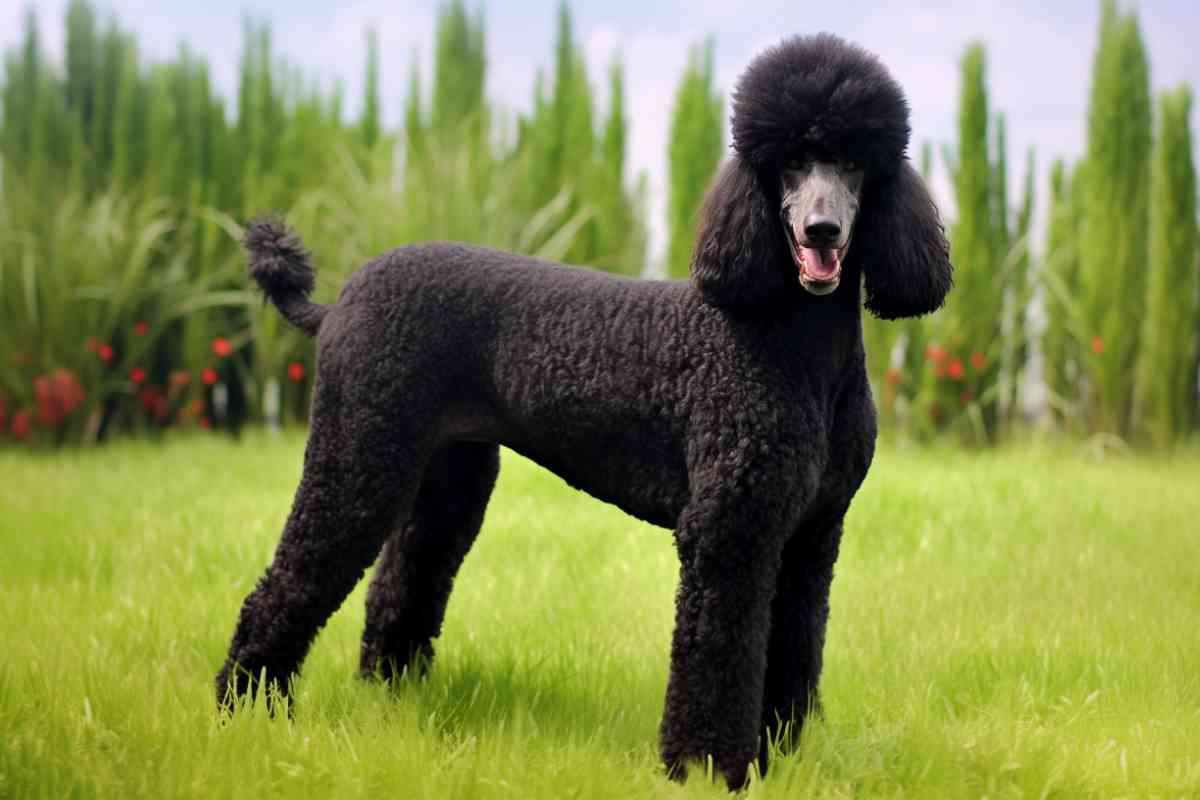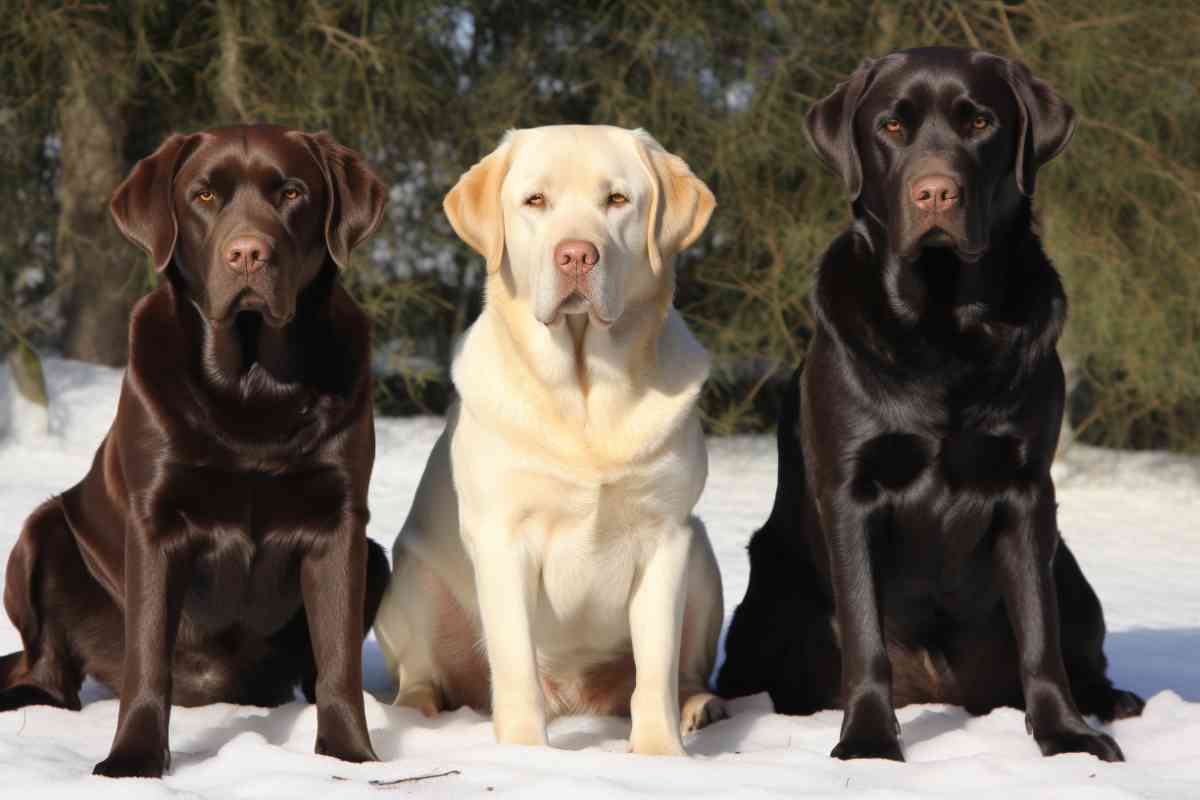Full Grown Labradoodle vs Goldendoodle: Which Is the Better Dog Breed?
Labradoodles and Goldendoodles are two of the most popular crossbreeds in the world. These dogs are a result of breeding a Labrador Retriever with a Poodle or a Golden Retriever with a Poodle, respectively. While both breeds share many similarities, there are also some key differences between them that prospective owners should be aware of.

Full Grown Labradoodle vs Goldendoodle: Which Is the Better Dog Breed?
Choosing between a full-grown Labradoodle and Goldendoodle depends on personal preference and lifestyle. Labradoodles are energetic, outgoing, and have a wavy or curly coat. Goldendoodles are friendly, affectionate, and have a straighter coat. Both are hypoallergenic, intelligent, and great family pets.
Wondering about what full grown really means in Labradoodles and Goldendoodles? Here’s a guide to mini and standard sizes.
Are you concerned about the coat you’ll end up with? Here’s a guide to doodle coat types.
One of the most significant differences between Labradoodles and Goldendoodles is their coat type. Labradoodles tend to have a wavy or curly coat that is more similar to a Poodle’s coat, while Goldendoodles have a straighter coat that is more similar to a Golden Retriever’s coat. However, both breeds are low-shedding and considered hypoallergenic, making them great options for people with allergies.
Another difference between the two breeds is their temperament. Labradoodles tend to be more energetic and outgoing than Goldendoodles, which can make them better suited for families with children or active lifestyles. Goldendoodles, on the other hand, are known for their friendly and affectionate nature, making them great companions for people who want a dog that loves to cuddle.

Key Takeaways
- Labradoodles and Goldendoodles are popular crossbreeds that share many similarities but also have key differences.
- Labradoodles tend to have a wavy or curly coat and a more energetic temperament, while Goldendoodles have a straighter coat and are known for being friendly and affectionate.
- Both breeds are low-shedding and hypoallergenic, making them great options for people with allergies.
Why choose a full-grown Labradoodle or Goldendoodle over a puppy?
There are several compelling reasons. Firstly, you’re skipping the puppy phase. Puppies are adorable, aren’t they? But they’re also a handful.
They require constant attention, training, and socialization. With a full-grown dog, you’re bypassing the demanding puppy stage. Secondly, you’re getting a dog with a known personality. Puppies can be unpredictable.
As they grow, their personalities develop and change. With a full-grown dog, what you see is what you get. You’ll know if they’re energetic or laid-back, sociable or reserved. Thirdly, you’re potentially saving a life.
Many full-grown dogs need homes. By choosing an adult dog, you’re giving them a second chance at a happy life.
Lastly, you’re getting a dog that’s likely house-trained. Potty training a puppy can be a challenging and time-consuming task. Most adult dogs are already house-trained, saving you a lot of time and effort.
So, are you ready to welcome a full-grown Labradoodle or Goldendoodle into your home? Remember, every dog deserves a loving home, regardless of their age.
Origins and History
The Labradoodle and Goldendoodle are two of the most popular hybrid dog breeds. Both breeds are a cross between a Poodle and another breed, with the Labradoodle being a cross between a Poodle and a Labrador Retriever, and the Goldendoodle being a cross between a Poodle and a Golden Retriever.

The Labradoodle was first bred in Australia in the 1980s by Wally Conron, who was working for the Royal Guide Dog Association of Australia. The goal was to create a hypoallergenic guide dog for people with allergies. The first Labradoodle was a cross between a Standard Poodle and a Labrador Retriever. The breed gained popularity quickly and has since become a popular family pet.
The Goldendoodle, on the other hand, was first bred in the United States in the 1990s. The breed was created by Monica Dickens, who was looking for a hypoallergenic guide dog for her husband. The first Goldendoodle was a cross between a Standard Poodle and a Golden Retriever.
Both breeds have since become extremely popular as family pets due to their friendly, social, and affectionate nature. They are also highly intelligent and easy to train, making them great dogs for first-time owners.

| Breed | Origin | Year |
|---|---|---|
| Labradoodle | Australia | 1980s |
| Goldendoodle | United States | 1990s |
In conclusion, the Labradoodle and Goldendoodle are two of the most popular hybrid dog breeds today due to their hypoallergenic coats, friendly personalities, and ease of training. They were both created with a specific purpose in mind and have since become beloved family pets.

Appearance and Size
When it comes to appearance, both Labradoodles and Goldendoodles are known for their cute and fluffy looks. However, there are some differences between the two breeds. Goldendoodles tend to have a wavy or curly coat that can be either long or short, while Labradoodles have a straighter coat that is usually longer. Both breeds can come in a variety of colors, including cream, gold, black, and chocolate.
In terms of size, both breeds can vary quite a bit. The genetic architecture of dogs, including the factors that influence size, is another important aspect to consider when comparing the size of Labradoodles and Goldendoodles. Goldendoodles can range in height from 20 to 24 inches at the shoulder and weigh between 50 and 90 pounds when fully grown. Labradoodles, on the other hand, can be a bit larger, with a height of 21 to 24 inches and a weight of 50 to 65 pounds. However, it’s important to note that there can be quite a bit of variation within each breed, depending on factors such as genetics and diet.
When it comes to choosing between a Labradoodle and a Goldendoodle, it’s important to consider your lifestyle and living situation. If you have a smaller home or apartment, a Goldendoodle may be a better choice, as they tend to be a bit smaller than Labradoodles. However, if you have a larger home or yard and are looking for a more active dog, a Labradoodle may be a better fit.
Overall, both Labradoodles and Goldendoodles are great family pets that are known for their friendly personalities and adorable looks. Whether you choose a Labradoodle or a Goldendoodle, you’re sure to have a loyal and loving companion by your side.
Related Posts:

Coat and Colors
When it comes to Labradoodles and Goldendoodles, their coat type and color can vary greatly. Both breeds can have a curly coat, which is a result of their Poodle heritage. However, the texture and thickness of their coat can vary depending on the individual dog’s genetics.
In terms of coat color, both breeds can come in a variety of shades, including red, cream, gold, white, brown, silver, and even blue. It’s important to note that while some breeders may advertise certain coat colors as “rare” or “unique,” there is no scientific evidence to support these claims.
When choosing between a Labradoodle and a Goldendoodle, coat type and color may not be the most important factor to consider. Both breeds are known for their friendly and affectionate personalities, and they can make great family pets. However, if you have specific preferences for coat type or color, it’s important to communicate this with your breeder and choose a puppy that meets your criteria.
Related Posts:
Temperament and Personality
When it comes to temperament and personality, both Labradoodles and Goldendoodles are known for their friendly, intelligent, and loyal nature. They are generally happy, outgoing, and playful dogs that love to interact with their owners and other people. Both breeds are also sociable and tend to get along well with children and other pets.

A study on the expression of behavioral traits in Goldendoodles and Labradoodles has shown that these breeds exhibit unique behavioral characteristics, which may contribute to their popularity. The study provides a scientific basis for understanding the behavioral traits of these breeds, which can be useful for potential owners in understanding what to expect when adopting a Goldendoodle or Labradoodle.
However, there are some differences in temperament and personality between the two breeds. Labradoodles tend to be more outgoing and sociable than Goldendoodles. They are also more playful and energetic, which makes them great companions for active families. On the other hand, Goldendoodles are known for their calm and gentle nature. They are more laid-back and tend to be less energetic than Labradoodles.
In terms of intelligence, both breeds are highly intelligent and easy to train. They are quick learners and respond well to positive reinforcement techniques. However, Labradoodles tend to be more trainable than Goldendoodles. This is because they have a stronger work drive and are more eager to please their owners.
When it comes to loyalty, both breeds are known for their devotion to their owners. They are affectionate dogs that love to be around people. However, Labradoodles are generally more loyal than Goldendoodles. They are highly protective of their owners and will go to great lengths to keep them safe.
Overall, both Labradoodles and Goldendoodles are great family pets that have a lot to offer. When choosing between the two breeds, it’s important to consider your lifestyle and personality to find the perfect match for you.
| Trait | Labradoodle | Goldendoodle |
|---|---|---|
| Sociable | Very sociable and outgoing | Sociable and friendly |
| Energetic | High energy and playful | Laid-back and less energetic |
| Trainable | Highly trainable | Trainable |
| Loyal | Highly protective and loyal | Loyal and affectionate |

Training and Intelligence
When it comes to training and intelligence, both Labradoodles and Goldendoodles are known for their high level of trainability and intelligence. Both breeds are quick learners and eager to please, making them excellent candidates for obedience training, agility training, and other types of dog sports.
Labradoodles tend to be slightly more intelligent than Goldendoodles, but both breeds are highly trainable and intelligent. In fact, Labradoodles are often used as service dogs and therapy dogs due to their exceptional intelligence and trainability.
One way to measure a dog’s intelligence is through the number of repetitions it takes to learn a new command. According to Stanley Coren, a professor of psychology at the University of British Columbia, it takes an average of 5 repetitions for a Labradoodle to learn a new command, while it takes an average of 15 repetitions for a Goldendoodle to learn the same command.

However, it’s important to note that intelligence is not the only factor when it comes to training. A dog’s temperament, energy level, and motivation also play a significant role in their trainability. Both Labradoodles and Goldendoodles are known for their friendly and affectionate personalities, which can make training a more enjoyable experience for both the dog and the owner.
In terms of specific training needs, both breeds require regular exercise and mental stimulation to prevent boredom and destructive behavior. They respond well to positive reinforcement training methods, such as clicker training and treat rewards. It’s also important to socialize them from a young age to prevent shyness or aggression towards other dogs and people.
Overall, both Labradoodles and Goldendoodles are highly trainable and intelligent breeds that make excellent pets for families and individuals alike. With proper training and socialization, they can excel in a variety of activities and become well-behaved members of the family.
| Breed | Repetitions to Learn New Command |
|---|---|
| Labradoodle | 5 |
| Goldendoodle | 15 |
Exercise and Activity Level
When it comes to exercise and activity level, both Labradoodles and Goldendoodles are energetic breeds that require regular physical activity to stay healthy and happy. However, there are some differences in their exercise needs and energy levels.
Labradoodles tend to have a higher energy level than Goldendoodles, which means they require more exercise and playtime to burn off their excess energy. They are also known to be more active and playful than Goldendoodles, making them a great choice for families who enjoy outdoor activities such as hiking, running, and swimming.
On the other hand, Goldendoodles are also energetic but tend to have a more moderate energy level. They still require regular exercise and playtime, but they may not need as much as a Labradoodle. This makes them a good choice for families who enjoy outdoor activities but also want a dog that can be content with a more relaxed lifestyle.
To illustrate the differences in exercise needs, here’s a table comparing the two breeds:
| Breed | Exercise Needs |
|---|---|
| Labradoodle | High – needs at least 60 minutes of exercise per day |
| Goldendoodle | Moderate – needs at least 30 minutes of exercise per day |
It’s important to note that every dog is unique and may have different exercise needs based on their age, weight, and overall health. It’s always best to consult with a veterinarian to determine the appropriate exercise routine for your Labradoodle or Goldendoodle.
In summary, both Labradoodles and Goldendoodles are energetic breeds that require regular exercise and playtime to stay healthy and happy. However, Labradoodles tend to have a higher energy level and require more exercise than Goldendoodles. It’s important to consider your family’s lifestyle and activity level when choosing between these two breeds.

Health and Lifespan
When it comes to health and lifespan, both Labradoodles and Goldendoodles are generally healthy breeds with a lifespan of 10-15 years. A study found that Poodles, along with other breeds like the Shetland Sheepdog and Dachshund, tend to live longer than the average dog breed.
One great thing about both of these breeds is that they may be healthier than their purebred parents. Nationwide discusses the health data of Poodle-cross breeds, including Goldendoodles and Labradoodles, compared to their purebred parents. This white paper goes into more detail about the relative risk for cancer claims in Labradoodles and Goldendoodles.
However, like all breeds, they are prone to certain health issues.
A study found that Labradors are prone to obesity, which can lead to other health problems such as joint issues and diabetes in Labradoodles. Another study discusses the prevalence of elbow dysplasia in Labradors, a common health issue in this breed that can be passed down to doodle pups.
One of the main reasons why Labradoodles and Goldendoodles are popular is due to their hypoallergenic coat. However, it is important to note that no dog breed is completely hypoallergenic. Both breeds shed minimally, but regular grooming is still necessary to prevent matting and tangling of their fur.
Hip dysplasia and elbow dysplasia are common health concerns for both breeds. These conditions occur when the hip or elbow joint does not develop properly, leading to discomfort and reduced mobility. Regular exercise and a healthy diet can help prevent these conditions, but it is important to have your dog screened for them regularly.
Goldendoodles may be prone to certain health issues such as ear infections, skin allergies, and bloat. This research discusses the Golden Retriever Lifetime Study, which investigates the incidence and risk factors for disease outcomes, especially cancer, in Golden Retrievers. Labradoodles may be prone to eye problems such as cataracts and progressive retinal atrophy. Regular check-ups with a veterinarian can help catch these issues early on and prevent them from becoming more serious.
In terms of lifespan, both breeds have a similar life expectancy of 10-15 years. However, lifespan can vary depending on factors such as genetics, diet, and exercise. Providing your dog with a healthy lifestyle and regular veterinary care can help ensure a longer lifespan.
Related Posts:
Care and Maintenance
Both Labradoodles and Goldendoodles require regular grooming to prevent matting and tangling of their fur. Brushing their coat at least once a week can help prevent matting and keep their fur healthy and shiny. Goldendoodles are more prone to matting than Labradoodles, so it is important to use the right brushes and combs. A slicker brush, a pin brush, and a metal comb are the three essential tools every Goldendoodle owner should have in their grooming kit.
In terms of feeding, both breeds require a high-quality diet that is rich in protein and other essential nutrients. It is important to avoid feeding them table scraps or human food that can upset their stomachs.
Both breeds are social and intelligent dogs that require mental and physical stimulation to prevent boredom and separation anxiety. Daily exercise, playtime, and training sessions can help keep them happy and healthy.
Overall, both breeds require regular care and maintenance to keep them healthy and happy. By providing them with a high-quality diet, regular grooming, and plenty of mental and physical stimulation, you can ensure that your Labradoodle or Goldendoodle is a happy and well-adjusted member of your family.
Related Posts:
- How to prevent Goldendoodle matting: 3 brushes you must own
- The ultimate guide to what a Goldendoodle can and cannot eat
- How to take care of a Goldendoodle puppy: 15 veterinarian tips

Suitability as Pets
When it comes to choosing between a full-grown Labradoodle and a Goldendoodle as pets, there are several factors to consider. Both breeds are popular and have their own unique characteristics that make them great pets. However, there are some differences that may make one breed more suitable for your lifestyle and family than the other.
Firstly, both Labradoodles and Goldendoodles are great pets for families with kids. They are friendly, affectionate, and playful, making them perfect companions for young children. However, it’s important to note that both breeds can be quite energetic, so it’s important to make sure your kids can handle their energy levels.
When it comes to comparison, Labradoodles are generally larger than Goldendoodles, which may make them more suitable for families with larger living spaces. However, Goldendoodles are generally more adaptable to different living environments, making them a great choice for families with smaller living spaces.
In terms of lifestyle, both breeds require regular exercise and grooming. Labradoodles have a more curly coat, which requires more frequent grooming to prevent matting. Goldendoodles, on the other hand, have a wavy coat that is easier to maintain. Both breeds are also prone to certain health issues such as hip dysplasia, so it’s important to keep up with regular vet check-ups.
To summarize, both Labradoodles and Goldendoodles make great family pets. When choosing between the two, it’s important to consider your family’s lifestyle and living space. A table comparing the two breeds is shown below:
| Labradoodle | Goldendoodle | |
|---|---|---|
| Size | Larger | Smaller |
| Coat | Curly, requires more grooming | Wavy, easier to maintain |
| Adaptability | Better for larger living spaces | More adaptable to different living environments |
| Health | Prone to hip dysplasia | Prone to hip dysplasia |
| Energy Level | High | High |
| Family Friendly | Yes | Yes |
| Kids Friendly | Yes | Yes |
Special Roles
Labradoodles and Goldendoodles are popular breeds for various roles such as guide dogs, service dogs, therapy dogs, and hypoallergenic guide dogs. Both breeds have unique characteristics that make them suitable for specific roles.
Guide Dogs
Guide dogs are trained to assist people with visual impairments to navigate safely. Both Labradoodles and Goldendoodles can make excellent guide dogs due to their intelligence, loyalty, and trainability. However, Labradoodles are more commonly used as guide dogs due to their hypoallergenic coat and calm temperament.
Service Dogs
Service dogs are trained to assist people with disabilities such as mobility issues, hearing impairments, and medical conditions. Both Labradoodles and Goldendoodles can make great service dogs due to their intelligence, loyalty, and trainability. However, Labradoodles are more commonly used as service dogs due to their hypoallergenic coat and calm temperament.
Therapy Dogs
Therapy dogs are trained to provide comfort and support to people in hospitals, schools, and nursing homes. Both Labradoodles and Goldendoodles can make excellent therapy dogs due to their friendly and sociable nature. However, Goldendoodles are more commonly used as therapy dogs due to their affectionate and gentle temperament.
Hypoallergenic Guide Dogs
Hypoallergenic guide dogs are trained to assist people with visual impairments who have allergies to dogs. Both Labradoodles and Goldendoodles are hypoallergenic breeds, which makes them suitable for this role. However, Labradoodles are more commonly used as hypoallergenic guide dogs due to their low-shedding coat and calm temperament.
In summary, both Labradoodles and Goldendoodles can make excellent guide dogs, service dogs, therapy dogs, and hypoallergenic guide dogs. However, the specific breed used for each role may vary based on the individual dog’s temperament, coat type, and other factors.
| Role | Labradoodle | Goldendoodle |
|---|---|---|
| Guide Dog | Commonly used due to hypoallergenic coat and calm temperament | Can also be used due to intelligence and trainability |
| Service Dog | Commonly used due to hypoallergenic coat and calm temperament | Can also be used due to intelligence and trainability |
| Therapy Dog | Can be used due to friendly and sociable nature | Commonly used due to affectionate and gentle temperament |
| Hypoallergenic Guide Dog | Commonly used due to low-shedding coat and calm temperament | Can also be used due to hypoallergenic coat |
Breed Popularity and Cost
Labradoodles and Goldendoodles are both designer dog breeds that have gained popularity in recent years. According to the American Kennel Club, neither of these breeds are recognized as official breeds, but they are still highly sought after by dog lovers.
Both Labradoodles and Goldendoodles are popular because they are hypoallergenic and have friendly temperaments. They are also known for being intelligent and easy to train. However, there are some differences between the two breeds when it comes to popularity and cost.
In terms of popularity, both breeds are quite popular, but Goldendoodles are slightly more popular than Labradoodles. This may be because Goldendoodles are a cross between a Golden Retriever and a Poodle, which are both very popular breeds. Labradoodles, on the other hand, are a cross between a Labrador Retriever and a Poodle, which are also popular breeds, but not quite as popular as Golden Retrievers.
When it comes to cost, both breeds can be quite expensive. However, Goldendoodles tend to be more expensive than Labradoodles. The cost of a Goldendoodle can range from $1,500 to $4,000 or more, depending on the breeder and the quality of the dog. Labradoodles, on the other hand, can range from $1,000 to $3,000 or more.
The cost of these breeds can also vary depending on the size of the dog. Smaller dogs tend to be more expensive than larger dogs. For example, a miniature Goldendoodle can cost more than a standard Goldendoodle, and a toy Labradoodle can cost more than a standard Labradoodle.
When it comes to finding a breeder, it’s important to do your research and find a reputable breeder. Both breeds are popular among puppy mills and backyard breeders, so it’s important to find a breeder who is responsible and ethical.
In conclusion, both Labradoodles and Goldendoodles are popular designer dog breeds that are known for their hypoallergenic coats and friendly temperaments. While both breeds can be expensive, Goldendoodles tend to be more expensive than Labradoodles. It’s important to do your research and find a reputable breeder when looking to add one of these dogs to your family.
| Breed | Popularity | Cost |
|---|---|---|
| Labradoodle | Popular | $1,000 to $3,000+ |
| Goldendoodle | More popular | $1,500 to $4,000+ |
Frequently Asked Questions
What are the differences in size between a Labradoodle and a Goldendoodle?
Both Labradoodles and Goldendoodles come in different sizes, depending on the size of their Poodle parent. Generally, Labradoodles are larger than Goldendoodles. Standard Labradoodles can weigh between 50-90 pounds, while standard Goldendoodles typically weigh between 50-80 pounds. Miniature Labradoodles can weigh between 15-45 pounds, while miniature Goldendoodles typically weigh between 15-35 pounds.
What are the pros and cons of a Goldendoodle compared to a Labradoodle?
Both breeds are known for being friendly, intelligent, and affectionate. Goldendoodles tend to be more social and outgoing, while Labradoodles are more reserved and independent. Goldendoodles are also typically easier to train and have a lower risk of health issues. However, Labradoodles are known for their loyalty and protective nature.
Which breed, Goldendoodle or Labradoodle, is better for people with allergies?
Both breeds are considered hypoallergenic, as they have a low-shedding coat. However, it is important to note that no dog breed is completely hypoallergenic. Some people may still have allergic reactions to these breeds.
What is the personality of a Labradoodle compared to a Goldendoodle?
Both breeds are known for being friendly, intelligent, and affectionate. Goldendoodles tend to be more social and outgoing, while Labradoodles are more reserved and independent. Goldendoodles are also typically easier to train and have a lower risk of health issues. However, Labradoodles are known for their loyalty and protective nature.
Are Labradoodles or Goldendoodles more laid back?
Both breeds are known for their calm and laid-back personalities. However, Goldendoodles tend to be more energetic and playful, while Labradoodles are more relaxed and easy-going.
What is the average price range for a Labradoodle or Goldendoodle?
The price of a Labradoodle or Goldendoodle can vary depending on the breeder, location, and size of the dog. Generally, the average price range for a Labradoodle or Goldendoodle is between $1,500 and $3,000. However, some breeders may charge more for certain colors or coat types.